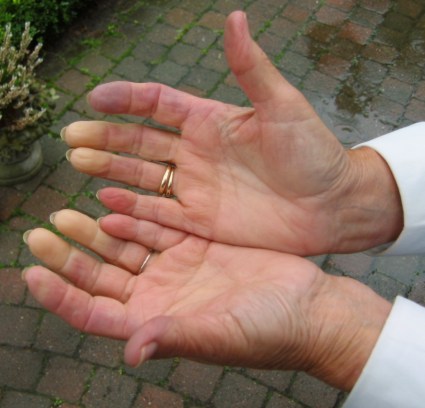Raynaud's disease
For patient information click here
| Raynaud disease | ||
 | ||
|---|---|---|
| Hands with Raynaud's disease | ||
| ICD-10 | I73.0 | |
| ICD-9 | 443.0 | |
| OMIM | 179600 | |
| DiseasesDB | 11186 | |
| MedlinePlus | 000412 | |
| eMedicine | med/1993 | |
| MeSH | C14.907.744 | |
Editors-In-Chief: Asghar Fakhri, M.D. and Duane S. Pinto, M.D.
Please Take Over This Page and Apply to be Editor-In-Chief for this topic: There can be one or more than one Editor-In-Chief. You may also apply to be an Associate Editor-In-Chief of one of the subtopics below. Please mail us [1] to indicate your interest in serving either as an Editor-In-Chief of the entire topic or as an Associate Editor-In-Chief for a subtopic. Please be sure to attach your CV and or biographical sketch.
Overview
Raynaud disease (RAY-noz) is a condition that affects blood flow to the extremities which include the fingers, toes, nose and ears when exposed to temperature changes or stress. It was named after Maurice Raynaud (1834 - 1881), a French physician who first described it in 1862.
Symptoms
The symptoms include several cyclic color changes:
- When exposed to cold temperatures, the oxygen supply to the fingertips, toes, nose, and earlobes of Raynaud's disease patients is reduced and the skin turns pale or white (called pallor) and becomes cold and numb.
- When the oxygen supply is depleted, the skin colour turns blue (called cyanosis).
- These events are episodic and when the episode subsides, or the area is warmed, blood returns to the area and the skin colour turns red (rubor) and then back to normal, often accompanied by swelling and tingling. These symptoms are thought to be due to reactive hyperemias of the areas deprived of blood flow.
All three colour changes are present in classic Raynaud's disease. However, some patients do not see all of the colour changes in all outbreaks of this condition.
Disease vs. phenomenon
It is important to distinguish Raynaud disease from Raynaud phenomenon. In order to diagnose these two forms of Raynaud, your doctor may look for signs of arthritis or vasculitis and conduct a number of laboratory tests.
Primary Raynaud (disease)
Raynaud's disease (or "Primary Raynaud's") is diagnosed if the symptoms occur only by themselves and are not accompanied by other diseases. Primary Raynaud's often develops in young women in their teens and young adulthood. This form of Raynaud's is thought to be hereditary, although it is uncertain if it is actually genetic or if it is simply recognized more often within families of people diagnosed with the disease.
Secondary Raynaud (phenomenon)
Raynaud's phenomenon (or "Secondary Raynaud's") occurs secondary to many different causes:
- The most common causes are connective tissue disorders such as systemic lupus erythematosus, scleroderma/systemic sclerosis/CREST syndrome, arthritis and many others.
- Other disorders that can be causes include carpal tunnel syndrome and obstructive arterial disease.
- Medications that can be causes include beta-blockers and ergotamine.
In contrast to the disease form, this form of Raynaud can progress to necrosis or gangrene of the fingertips.
Prevention
Patients with Raynaud's disease are advised to keep warm by wearing gloves and socks. They should also avoid stress, medicines that can constrict blood vessels such as decongestants and touching cold objects. Patients are also advised to avoid foods and activities that may constrict blood vessels such as drinking caffeinated drinks and smoking. Avoiding artificially cold environments, such as refrigerated or highly air conditioned spaces, can also help prevent episodes from occurring.
Treatment
Template:Seealso The severity of the disease runs from mild to severe. In people with mild cases, this may be simply an annoyance. Heatbands Hand warmers may be used on the wrists to warm the blood flowing to the hands. More serious cases require medical intervention due to the risks of gangrene and possible digital amputation. Microvascular surgery of the affected areas is a possible therapy.
Treatment for Raynaud's disease may include prescription medicines that dilate blood vessels, such as calcium channel blockers (nifedipine). Mild cases of Raynaud's can be addressed by biofeedback or a technique to help control involuntary body functions such as skin temperature. In severe cases, a sympathectomy procedure can be performed. Here, the nerves that signals the blood vessels of the fingertips to constrict are surgically cut.
References
- Raynaud AGM. De l'asphyxie locale et de la gangrène symétrique des extrémités. Academic thesis, Paris, Rignoux, 1862.
See also
External links
- HealthAtoZ - Raynaud's Disease
- What Is Raynaud's Disease
- Mayo Clinic - Raynaud's Disease
- Health In Plain English - Raynaud's Disease
- National Institute of Arthritis and Musculoskeletal and Skin Disease - Raynaud's Phenomenon
- "Gel improves circulation disorder" (from BBC News)
- Living with Raynaud's Disease